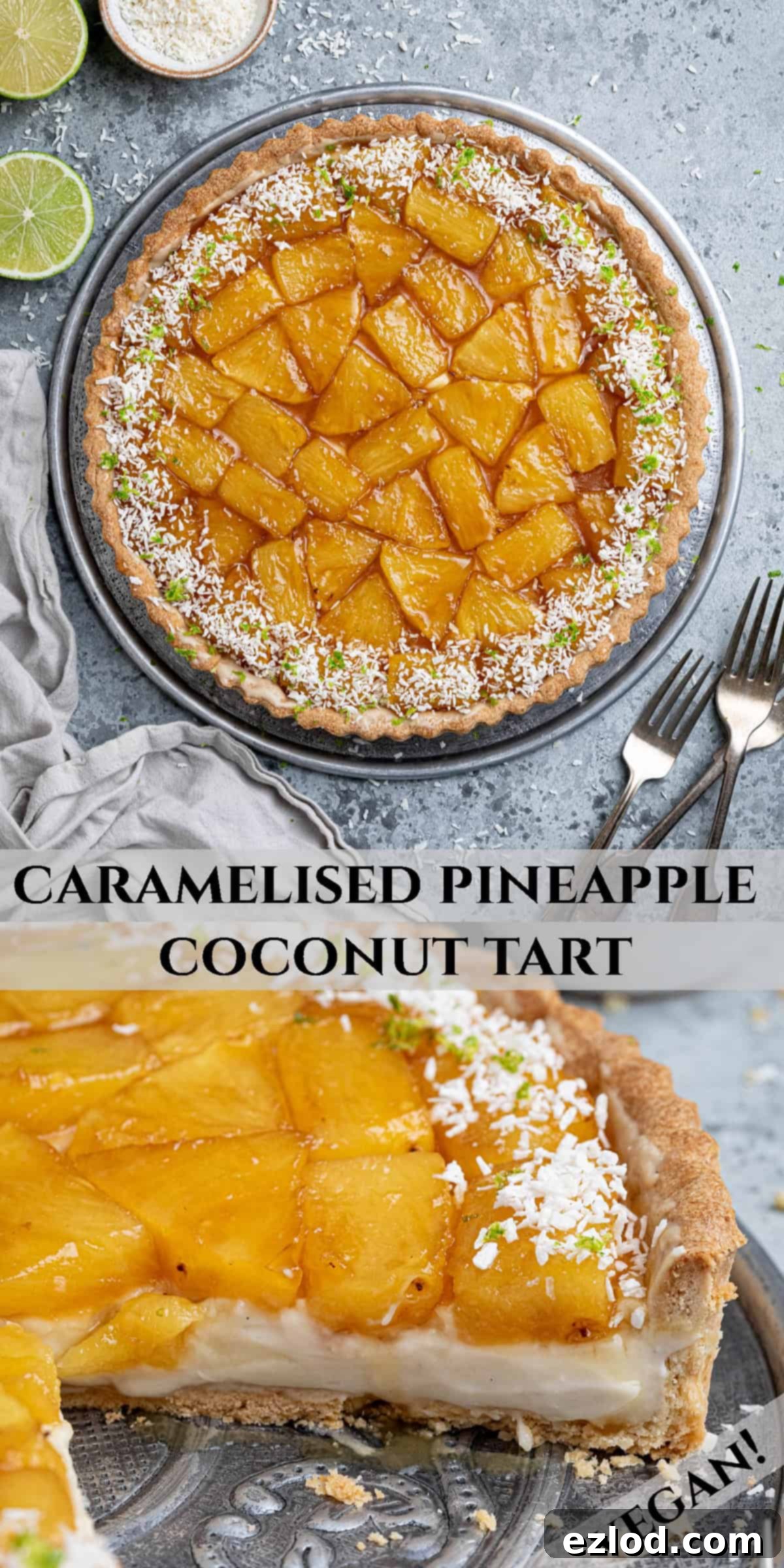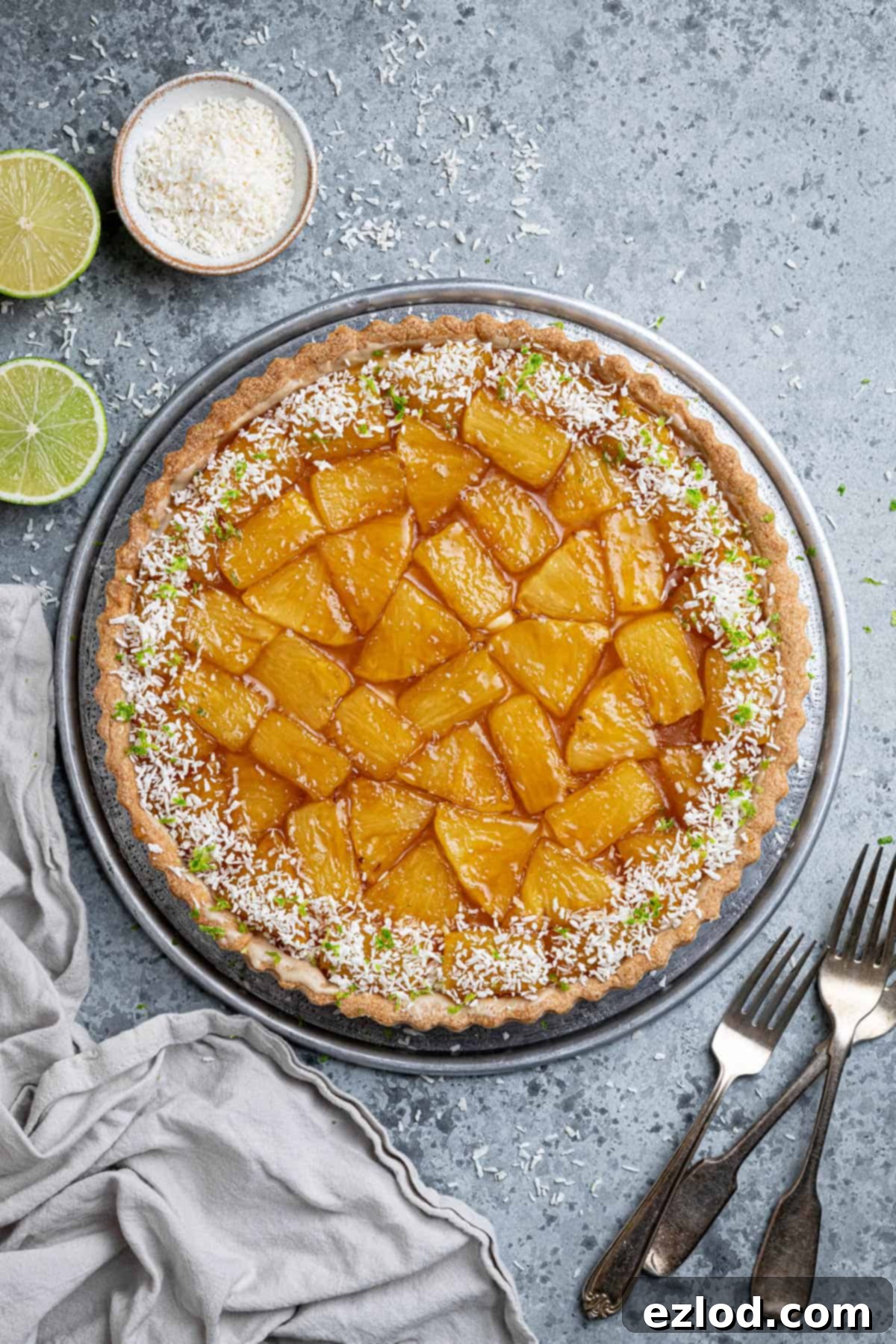Decadent Vegan Caramelised Pineapple Coconut Tart: A Tropical Summer Dessert Masterpiece
Prepare your taste buds for an extraordinary journey with this Caramelised Pineapple Coconut Tart – a truly exceptional vegan dessert that masterfully blends sweet, sticky rum-infused caramelised pineapple, a rich and creamy coconut rum pastry cream, all nestled within a perfectly crisp shortcrust pastry. This tart isn’t just a dessert; it’s a tropical flavour explosion, designed to transport you to sun-drenched beaches with every single bite.
While its elegant appearance might suggest a complex baking challenge, this delightful tart is surprisingly straightforward to create, yielding results that are both incredibly delicious and visually stunning. It’s the ultimate summer dessert, ideal for garden parties, family gatherings, or simply treating yourself to a taste of paradise.
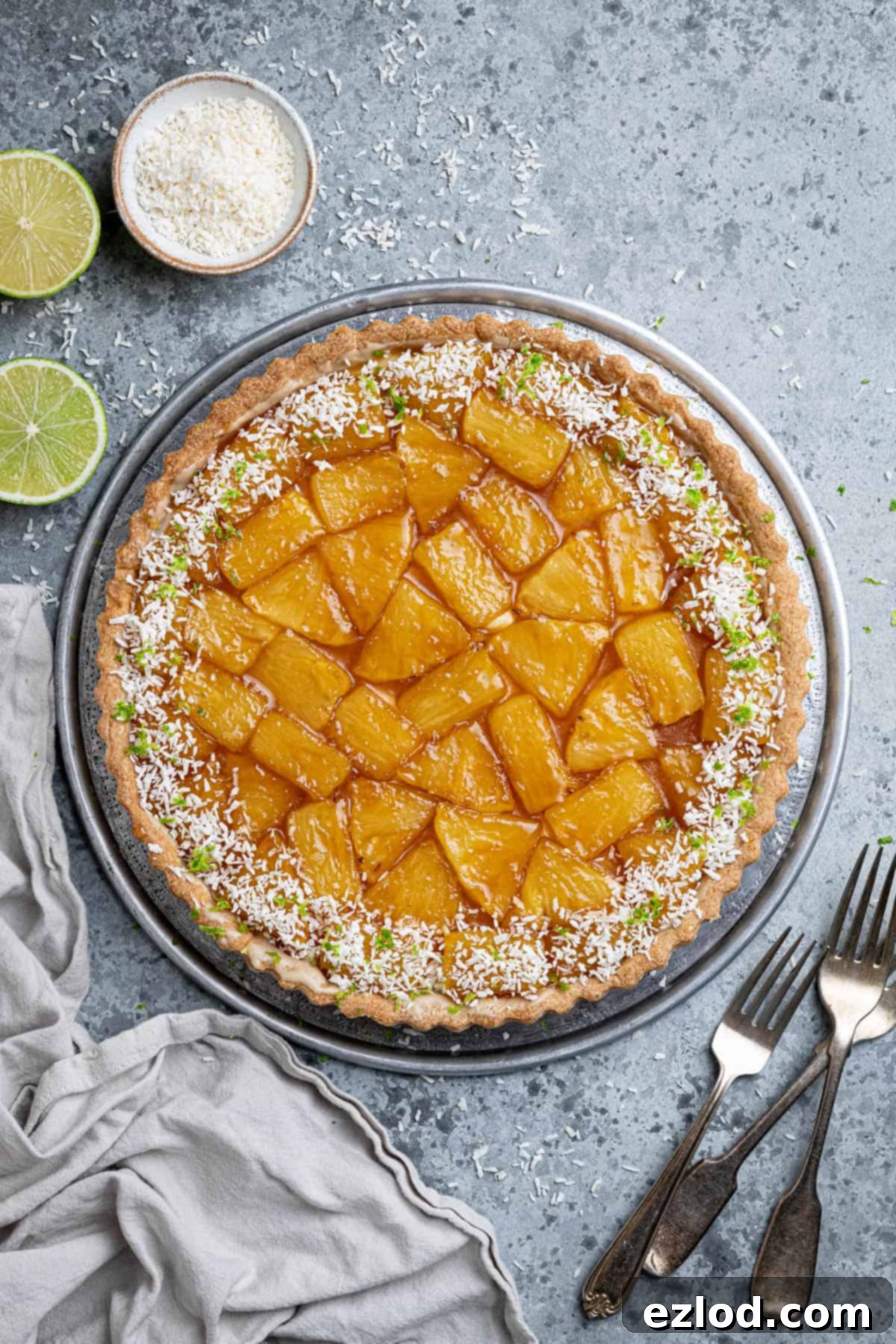
Few desserts can rival the simple yet profound satisfaction of a beautifully crafted tart, especially one generously filled with luscious crème pâtissière and adorned with fresh, vibrant fruit. This particular recipe takes that classic concept and elevates it to new tropical heights.
Our vegan Caramelised Pineapple Coconut Tart marries the rich, sweet tang of pineapple, pan-fried to perfection with brown sugar, lime, and a hint of dark rum, with a creamy, dreamy coconut and rum-infused crème pâtissière. This exquisite filling is then encased in a wonderfully crisp, golden shortcrust pastry. The synergy of these ingredients creates a symphony of textures and flavours – it’s a dessert that feels both luxuriously rich and wonderfully light, incredibly refreshing, and utterly addictive. You’ll find yourself reaching for another slice before you’ve even finished the first!
The star of our filling, the vegan pastry cream, is a delightful adaptation of my tried-and-true vegan creme pat recipe. The key difference here is the use of a full-fat can of coconut milk, which not only imparts a distinctive, delicate coconut flavour but also contributes to an unbelievably rich and smooth, creamy texture. To further enhance the tropical notes and add a layer of complexity, I’ve incorporated a touch of dark rum – a pairing that complements coconut exceptionally well. However, if you prefer to keep it alcohol-free, this addition is entirely optional, and the tart will still be spectacularly delicious.
The caramelised pineapple topping is a revelation in itself. Fresh pineapple chunks are first coated in a delightful mixture of brown sugar, dark rum, and fresh lime juice. They are then gently pan-fried until they begin to soften and take on a beautiful golden hue. The remaining sugary liquid is then added back to the pan, simmering down to form a thick, glossy, sticky caramel glaze that envelops each piece of pineapple. If you’ve never experienced the magic of cooked pineapple before, get ready for an absolute treat – its natural sweetness intensifies, and its texture becomes wonderfully tender and juicy.
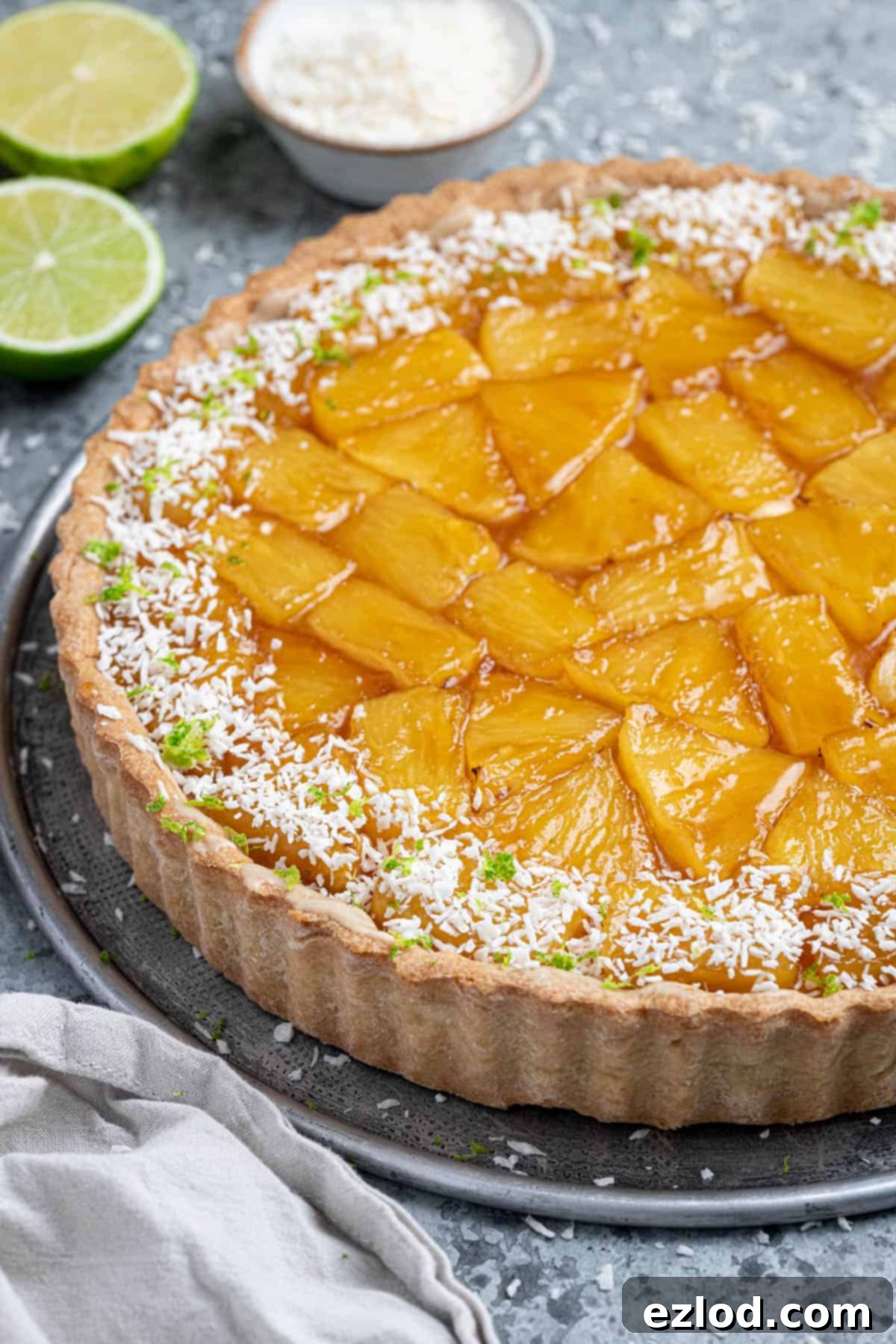
Key Ingredient Details & Tips for the Perfect Tart
Understanding the role of each ingredient is crucial for achieving the best possible results. Here’s a deeper dive into what you’ll need and why:
Pineapple: For this recipe, one medium-large fresh pineapple is ideal. Fresh pineapple offers the best flavour and texture, becoming juicy and tender when caramelised. While you *could* potentially use well-drained tinned pineapple chunks as an alternative, I strongly recommend fresh for a superior outcome, as I haven’t specifically tested the recipe with canned fruit.
Coconut Milk: The success of our rich crème pâtissière hinges on using one full-fat tin of coconut milk. It is absolutely essential to avoid light coconut milk or coconut drinking milk, as these will not provide the necessary fat content or thickness, resulting in a thin and watery cream. Look for full-fat coconut milk in a can, usually found in the international or baking aisle of most supermarkets.
Cornflour (Cornstarch): This humble ingredient is the unsung hero of our vegan pastry cream. Cornflour (or cornstarch, as it’s known in some regions) acts as our primary thickening agent, replacing the traditional egg yolks. Its starch properties create a beautifully smooth, glossy, and stable cream. I cannot stress enough the importance of sticking to cornflour; substituting it with other starches or flours like tapioca starch or plain flour will significantly alter the texture, leading to less desirable results.
Sugar: You’ll need three types of sugar for distinct purposes in this tart. White caster or granulated sugar is perfect for the pastry cream, providing clean sweetness. Icing (powdered) sugar is used in the pastry for a finer texture and easier incorporation, ensuring a tender bite. Finally, light brown soft sugar is specified for the pineapple caramelisation, as its molasses content adds depth of flavour and contributes to that wonderful sticky, rich caramel. I highly advise against swapping these sugar types for other kinds or alternative sweeteners, as each plays a specific role in texture and flavour development.
Rum: A good quality dark rum will infuse both the pineapple and the pastry cream with a deep, warming, and distinctly tropical flavour that pairs exquisitely with coconut. Brands like Captain Morgan or Gosling’s Black Seal work wonderfully. If dark rum isn’t available or preferred, something like Malibu (coconut rum) would also work, leaning into the coconut notes even further. For a non-alcoholic alternative, increase the lime juice slightly and add a splash of water or a non-alcoholic rum extract for flavour, though the depth will differ.
Vegan White Chocolate: This ingredient is optional but highly recommended for superior pastry integrity. Brushing the inside of your blind-baked pastry case with a thin layer of melted vegan white chocolate creates a protective barrier. This prevents the pastry from absorbing moisture from the creamy filling, ensuring your tart crust remains wonderfully crisp for longer. I source my oat milk blonde vegan chocolate couverture drops from here, but many other excellent vegan white chocolate options are available online and increasingly in well-stocked supermarkets.
Vegan Butter: When it comes to the pastry, the type of vegan butter you use makes a significant difference. It is crucial to use a firm block-style vegan butter or margarine, rather than the spreadable varieties that come in a tub. Block butter has a higher fat content and lower water content, essential for creating a flaky, crisp pastry. Brands like Naturli Vegan Block or Flora Plant Butter are excellent choices due to their consistent texture and performance in baking.
Plain Flour: Simple plain (all-purpose) flour is all you need for the pastry. It provides the necessary structure without interfering with the delicate texture created by the other ingredients.
Vodka: This is my (not-so) secret weapon for achieving an exceptionally crisp pastry! The science behind it is simple yet brilliant: alcohol has a lower water percentage compared to plain water. When you use a small amount of cold vodka to bind the pastry dough instead of just water, the alcohol evaporates much faster during baking. This rapid evaporation creates a lighter, flakier, and notably crispier crust because less moisture remains in the dough to develop gluten, which can lead to toughness. Rest assured, you absolutely cannot taste the vodka in the finished tart, as the alcohol completely bakes off. If you prefer or don’t have vodka on hand, cold water will work, but I strongly encourage you to try the vodka method for that extra special crispness if you have it.
Ground Almonds: Incorporating ground almonds into the pastry dough not only imparts a delicate, nutty flavour that harmonises beautifully with the coconut and pineapple but also contributes to a wonderfully tender and crisp texture. The fine fat content in the almonds helps to short the pastry, making it less prone to toughness. If you have an almond allergy or simply prefer not to use them, you can substitute them with an equal weight of plain flour, though the flavour profile will be slightly different.
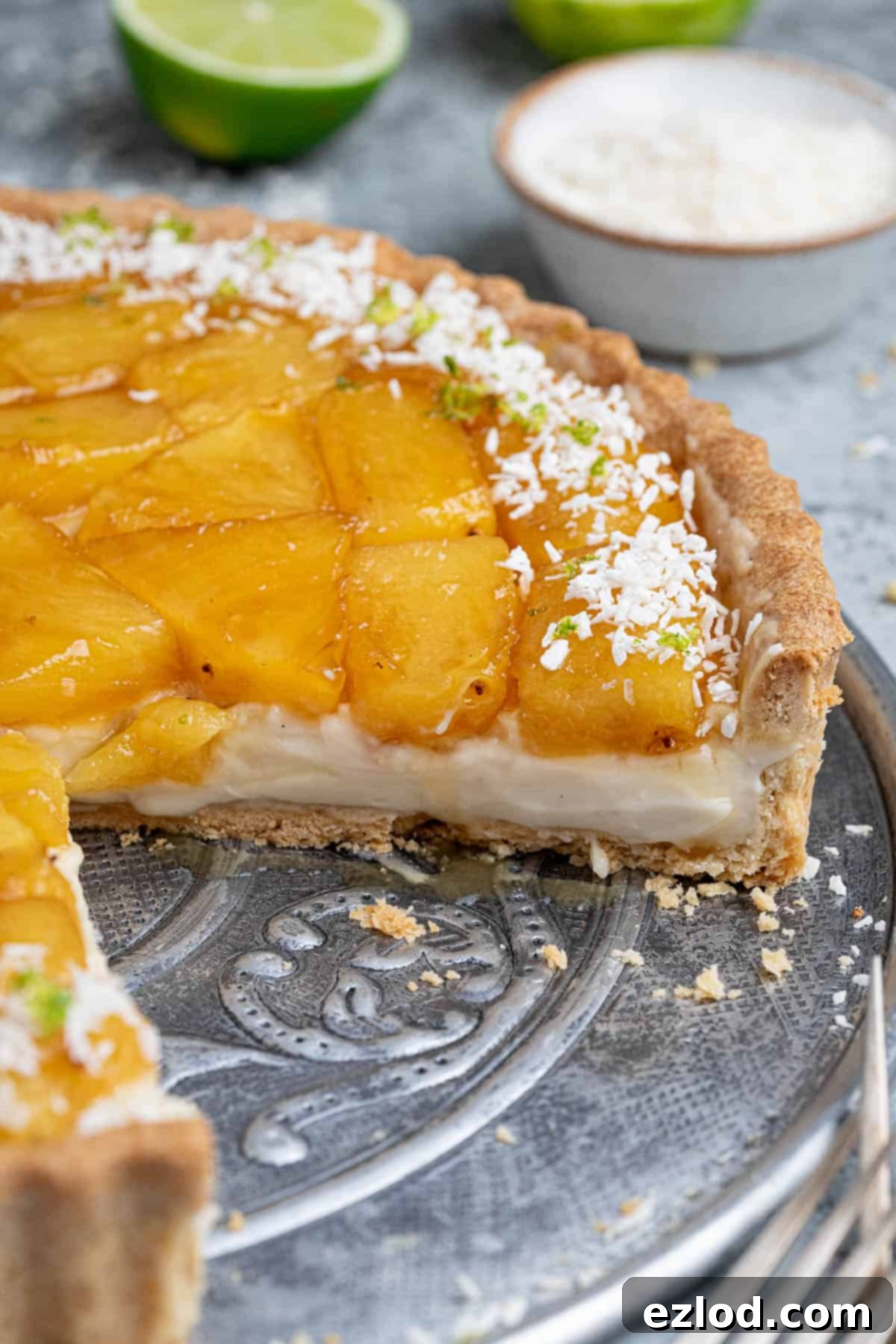
Crafting Your Tropical Masterpiece: A Step-by-Step Guide to Making Caramelised Pineapple Coconut Tart
(For precise measurements and detailed instructions, please refer to the comprehensive recipe card located at the bottom of this page.)
Step 1: The Art of Pastry Making. Begin by combining the plain flour, finely ground almonds, delicate icing sugar, and a pinch of salt in a spacious mixing bowl. Ensure these dry ingredients are thoroughly mixed. Next, introduce the cold, diced vegan block butter. Using your fingertips, gently rub the butter into the dry mixture until it transforms into a texture reminiscent of fine breadcrumbs, with no visible lumps of butter remaining. Now, add the cold vodka (if using) and mix until just combined. Gradually incorporate small amounts of ice-cold water, just enough to bring the pastry dough together into a cohesive ball. Be careful not to overwork the dough. Shape it into a flat disc, wrap it securely, and refrigerate for approximately one hour. This chilling process is vital for allowing the gluten to relax and the butter to firm up, ensuring a manageable and tender pastry.
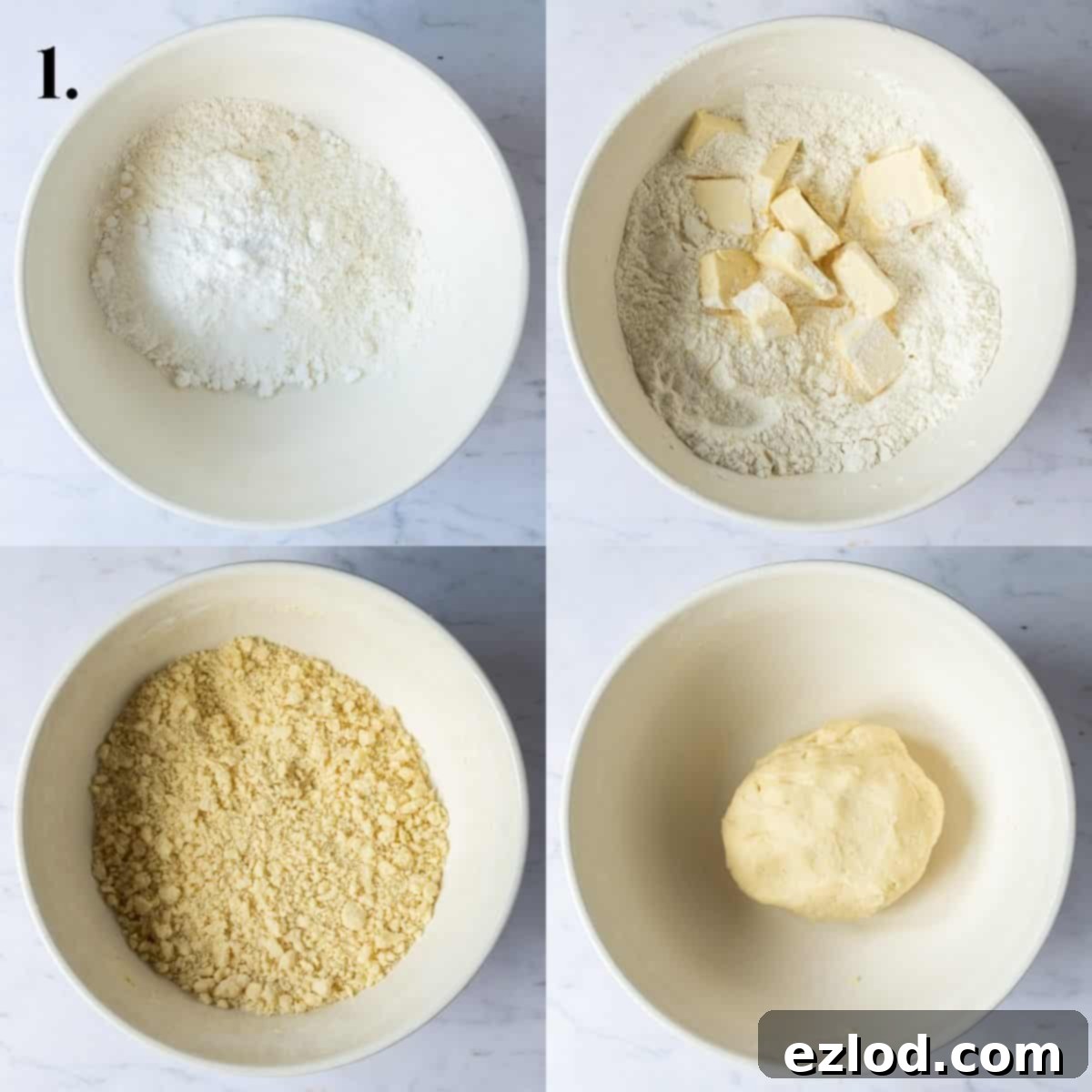
Step 2: Rolling and Chilling the Crust. On a lightly floured surface, carefully roll out your chilled pastry dough into a uniform circle. Aim for a size large enough to comfortably line a 23-25cm (9-10 inch) loose-bottomed tart tin. Gently transfer the rolled pastry into the tin, pressing it firmly into all the corners and up the sides to ensure a neat fit. Trim away any excess pastry from the edges. Using a fork, prick the base of the pastry shell all over – this helps prevent it from puffing up during baking. Place the prepared tart shell into the freezer for 20 minutes; this quick chill helps maintain its shape and crispness during baking.
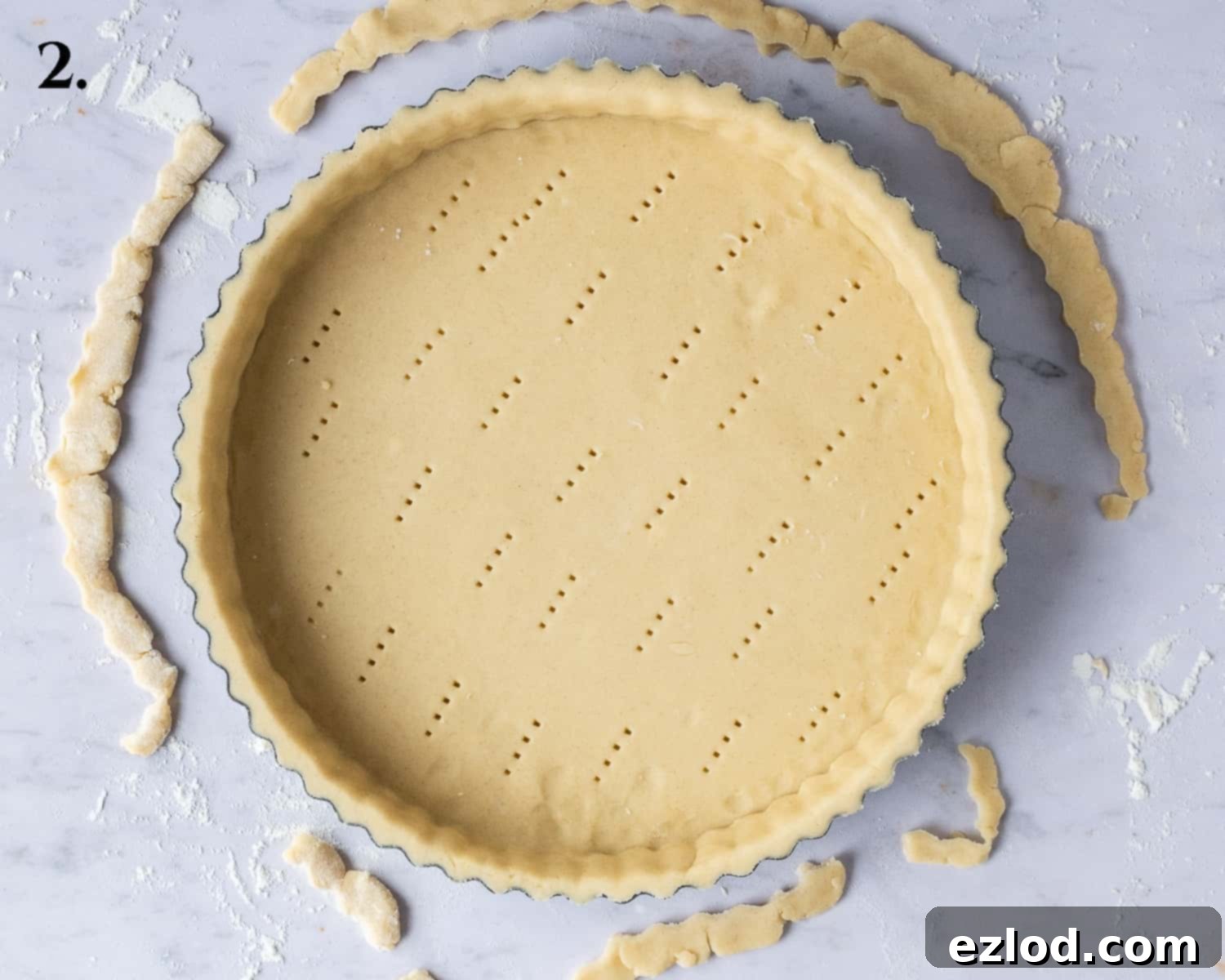
Step 3: Preparing for Blind Baking. Line the pastry case with a sheet of baking parchment. Make sure the parchment extends up the sides and into the corners of the tin. Fill this parchment-lined shell with baking beans or dried rice. These weights are essential for supporting the pastry walls and preventing them from slumping during blind baking, ensuring a perfectly shaped crust.
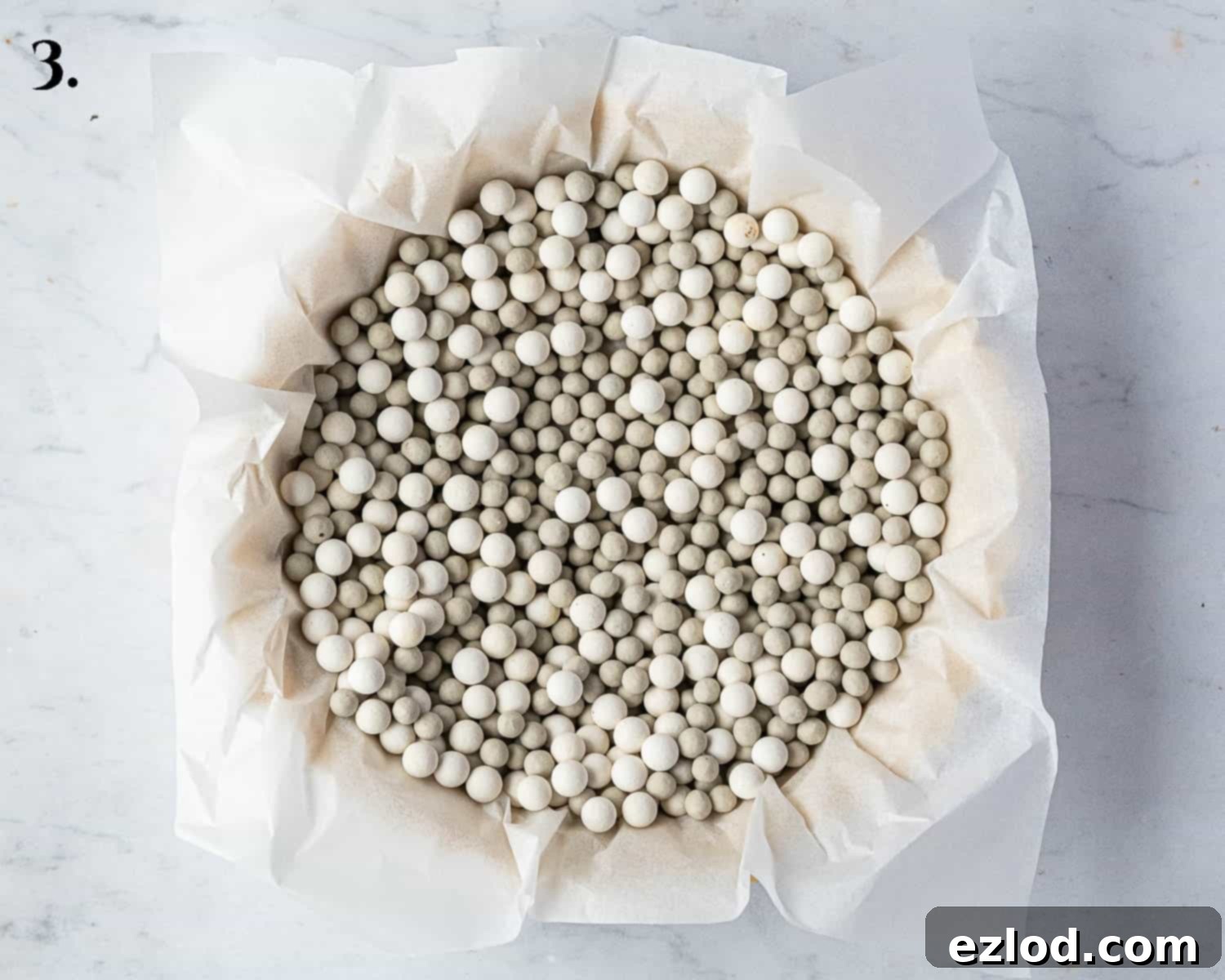
Step 4: Blind Baking the Pastry Shell. Preheat your oven to the specified temperature. Bake the weighted pastry case for an initial 25 minutes. After this time, carefully remove the baking parchment and beans. Return the partially baked tart shell to the oven for a further 15-20 minutes. This second baking phase allows the base to dry out and become golden brown and beautifully crisp, creating a robust foundation for your tart.
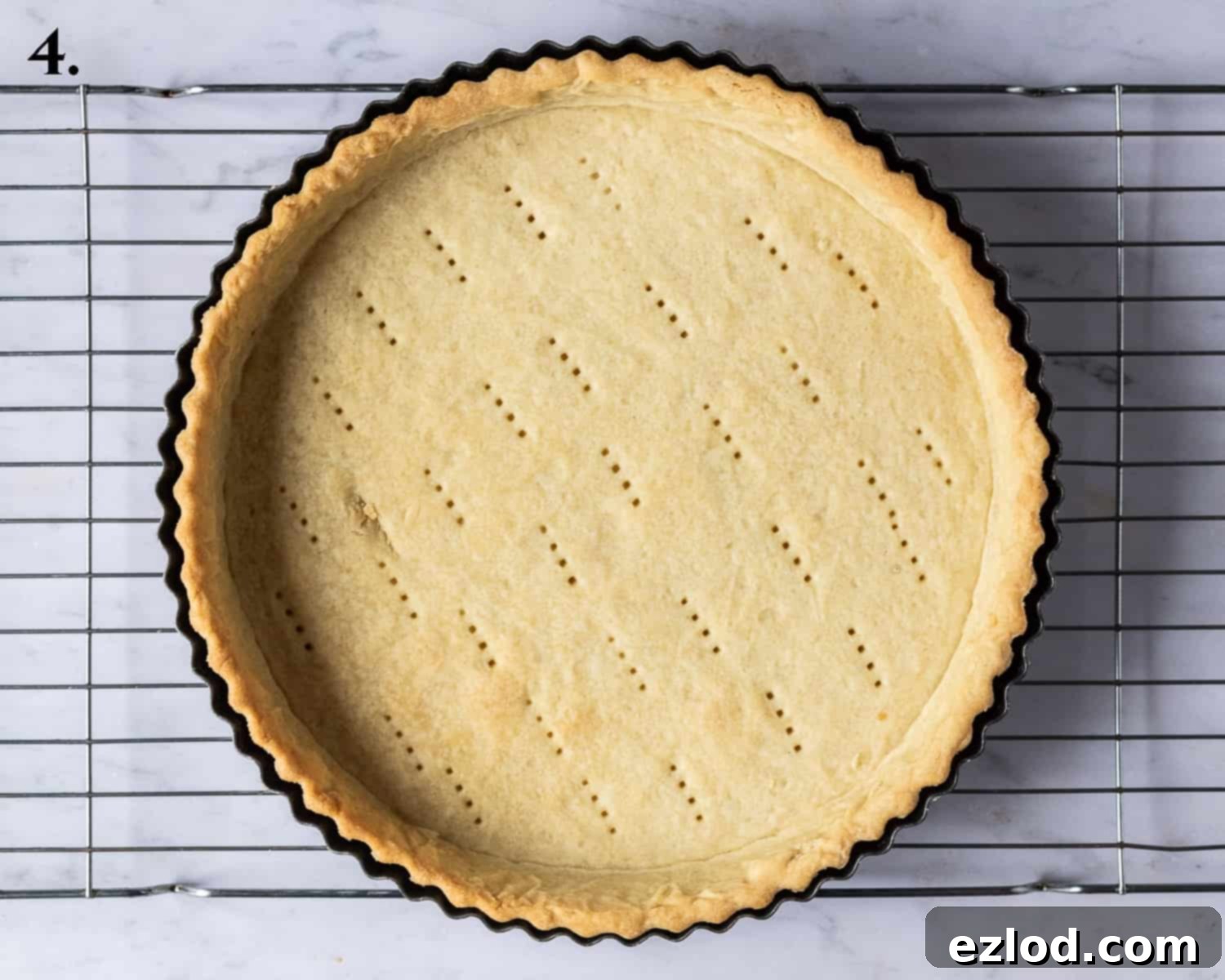
Step 5: Beginning the Crème Pâtissière. In a sturdy saucepan, place the cornstarch. Gradually whisk in the unsweetened non-dairy milk (soy milk works particularly well), ensuring there are absolutely no lumps – a smooth paste is key here. Once lump-free, whisk in the full-fat coconut milk, the caster or granulated sugar, and the vanilla bean paste or extract. Make sure all ingredients are well combined before heating.
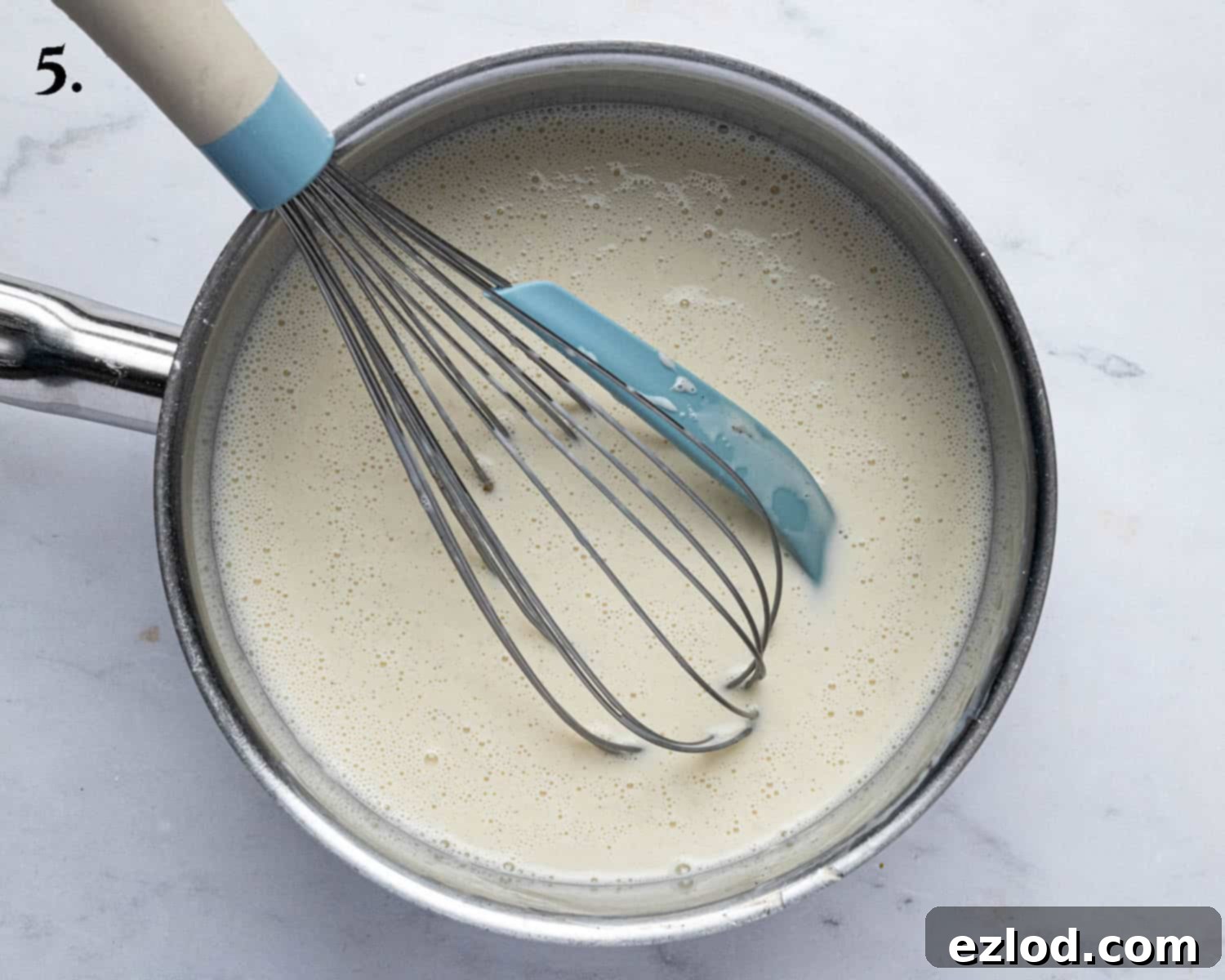
Step 6: Cooking the Pastry Cream to Perfection. Place the pan over a low to medium heat. The most important rule here is to stir constantly with a whisk, ensuring you reach every corner of the pan. This continuous agitation prevents sticking and lumping. Continue stirring until the mixture comes to a gentle boil and visibly thickens into a luxurious cream. Once thickened, remove the pan from the heat immediately. Stir in the vegan block butter until it has melted completely and is fully incorporated, then add the dark rum (if using) and stir again until everything is smooth and glossy.
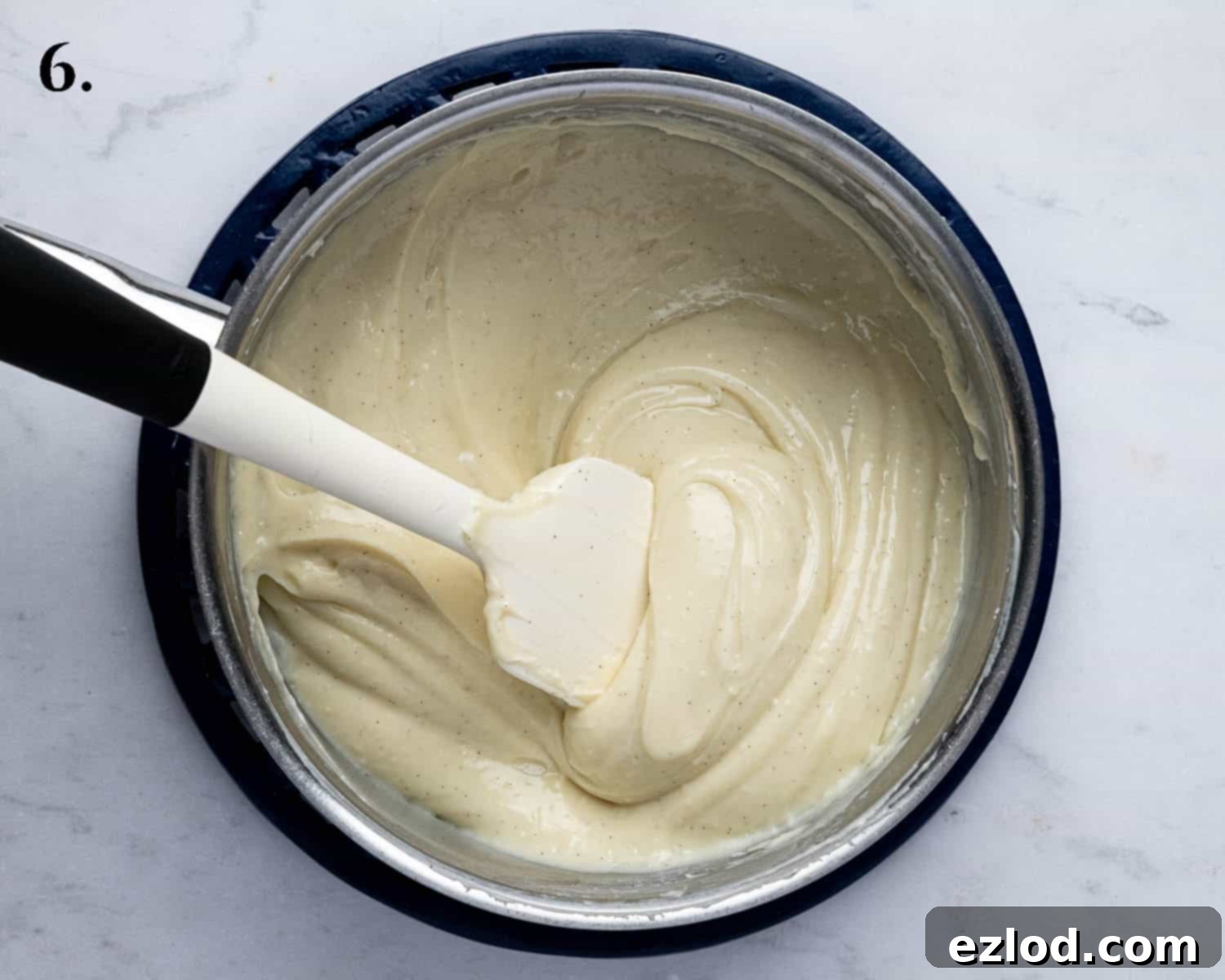
Step 7: Chilling the Crème Pâtissière. Scrape the hot pastry cream into a clean bowl. To prevent a “skin” from forming on the surface as it cools, cover it immediately with baking paper or clingfilm, ensuring the wrap is pressed directly onto the surface of the cream. Refrigerate for at least a couple of hours, or until thoroughly chilled and set. This cooling time allows the cream to firm up and fully develop its smooth, rich texture.
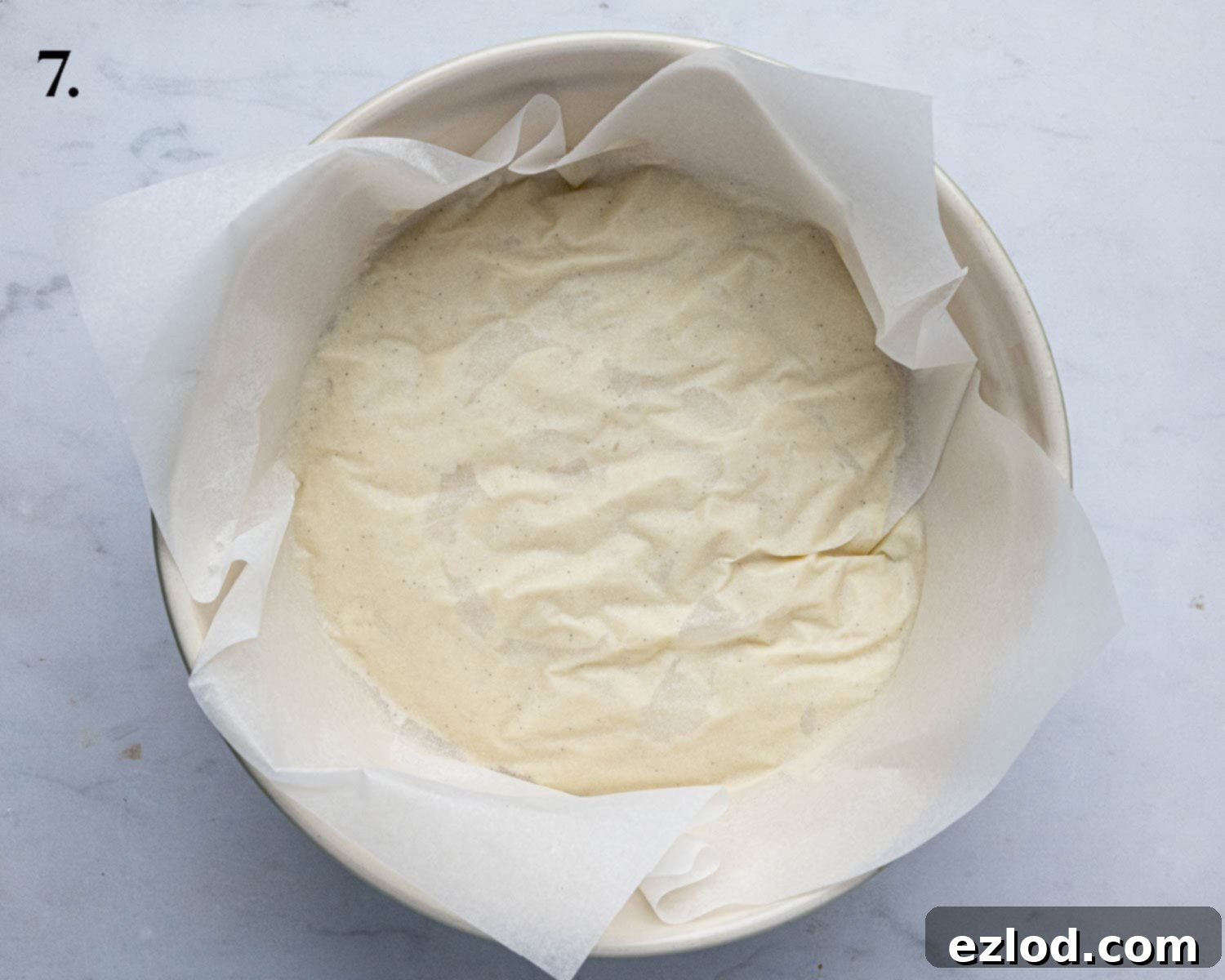
Step 8: Preparing the Pastry Case. Once your blind-baked pastry case has completely cooled, it’s time for the optional but beneficial step of sealing it. Brush the inside of the cooled pastry case evenly with melted vegan white chocolate. Allow this chocolate layer to set completely – this creates that crucial moisture barrier, ensuring your tart crust remains beautifully crisp even after being filled.
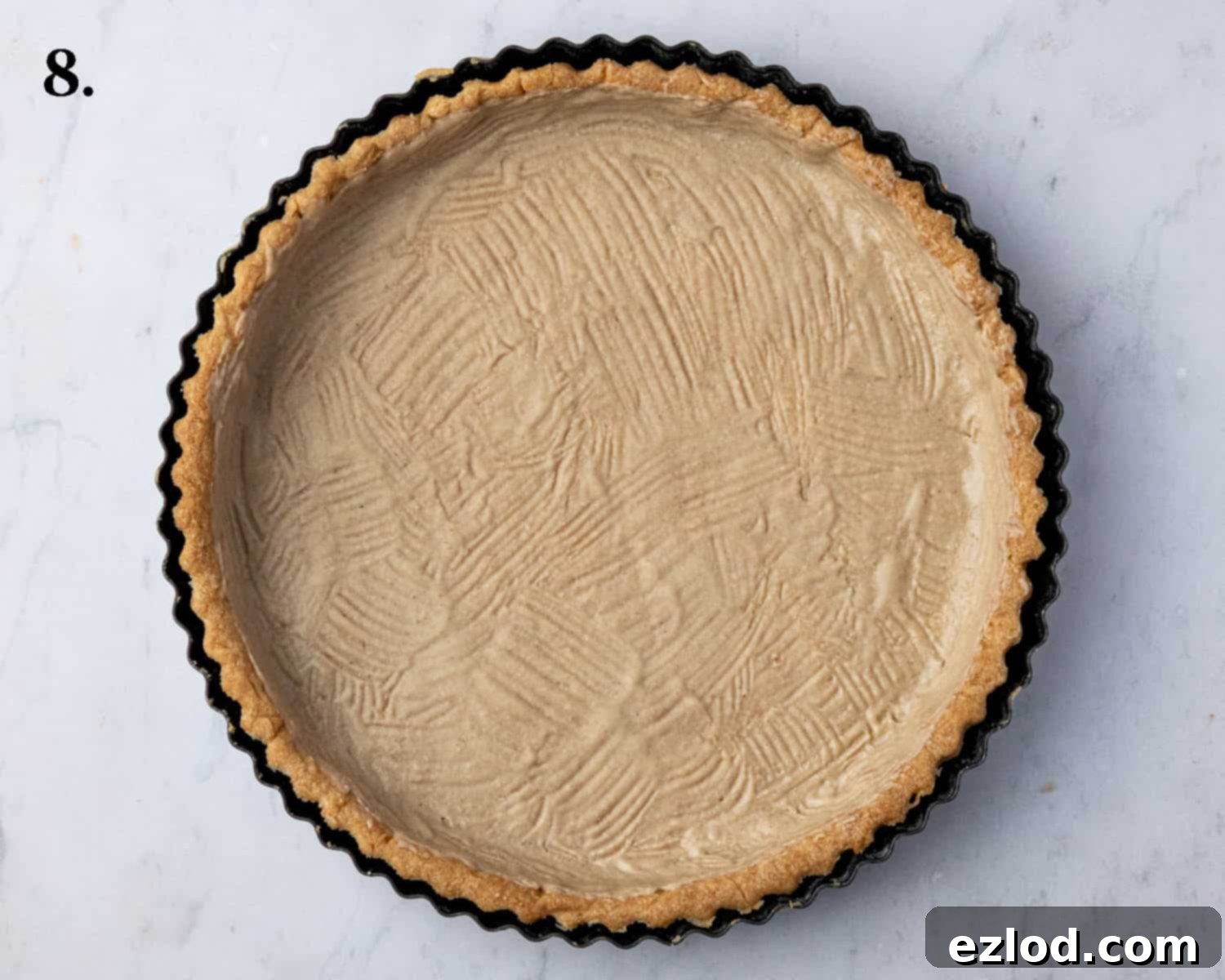
Step 9: Marinating the Pineapple. In a large bowl, combine the light brown soft sugar, dark rum, and the freshly squeezed juice of half a lime. Stir these ingredients together until the sugar begins to dissolve. Add your prepared fresh pineapple chunks to this mixture, tossing gently to ensure every piece is thoroughly coated in the fragrant liquid. Allow the pineapple to marinate briefly to absorb these wonderful flavours.
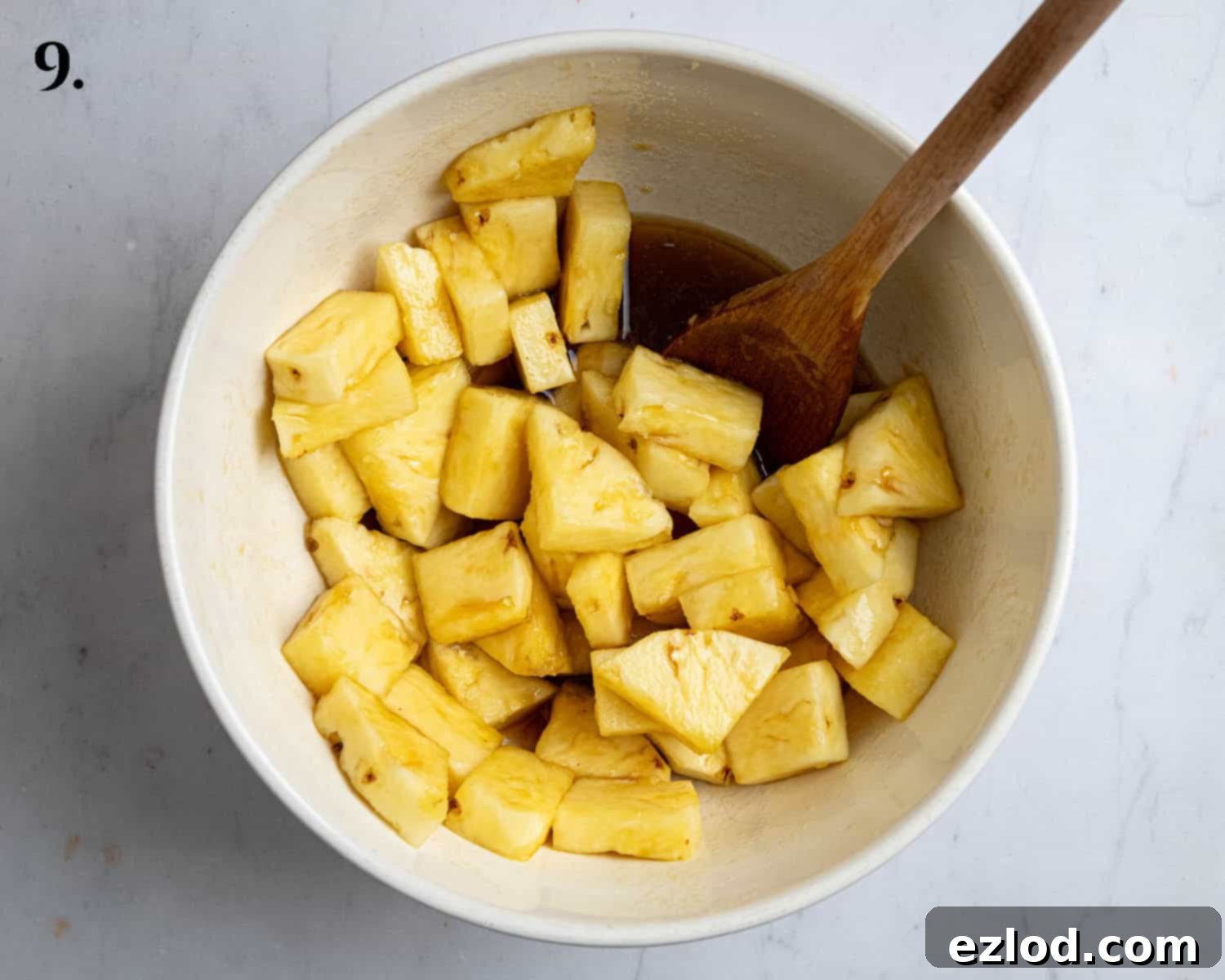
Step 10: Pan-Frying the Pineapple. Heat the vegan butter in a large, non-stick frying pan over a medium heat. Once the butter is melted and slightly shimmering, add the pineapple pieces to the pan in a single layer, making sure not to overcrowd the pan. Reserve any remaining sugary juice from the bowl for the next step. Cook the pineapple for approximately 4-5 minutes per side, or until the pieces are lightly golden brown and slightly softened. This step begins the caramelisation process and brings out the pineapple’s natural sweetness.
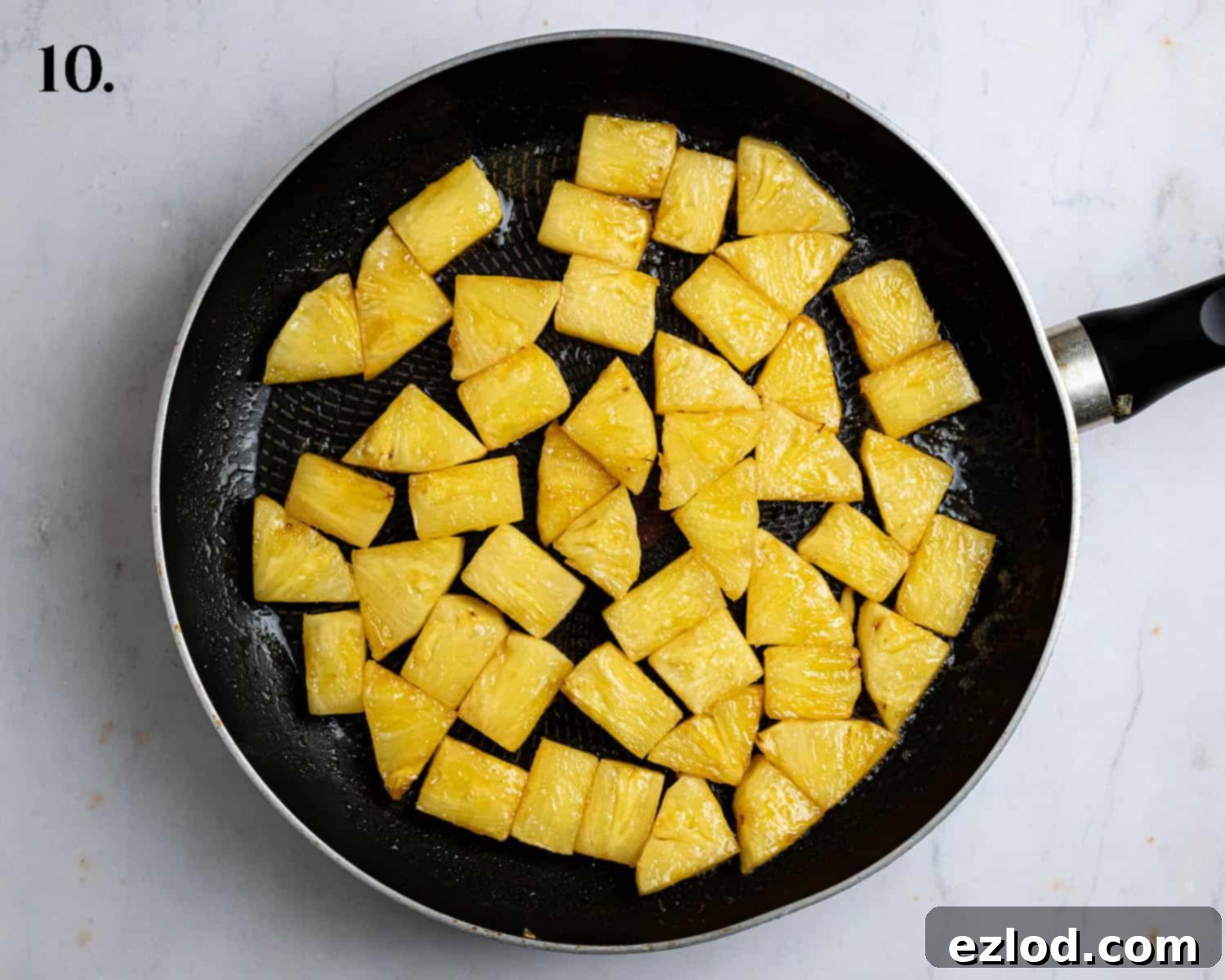
Step 11: Creating the Caramel Glaze. Once the pineapple is lightly browned, pour the reserved sugary liquid from the marinating bowl into the frying pan with the pineapple. Continue to simmer over medium heat, stirring occasionally, until the liquid has mostly evaporated and thickened into a luscious, sticky caramel syrup that beautifully coats the pineapple pieces. This process intensifies the flavours and creates that signature caramelised texture. Remove from heat and set aside to cool completely.
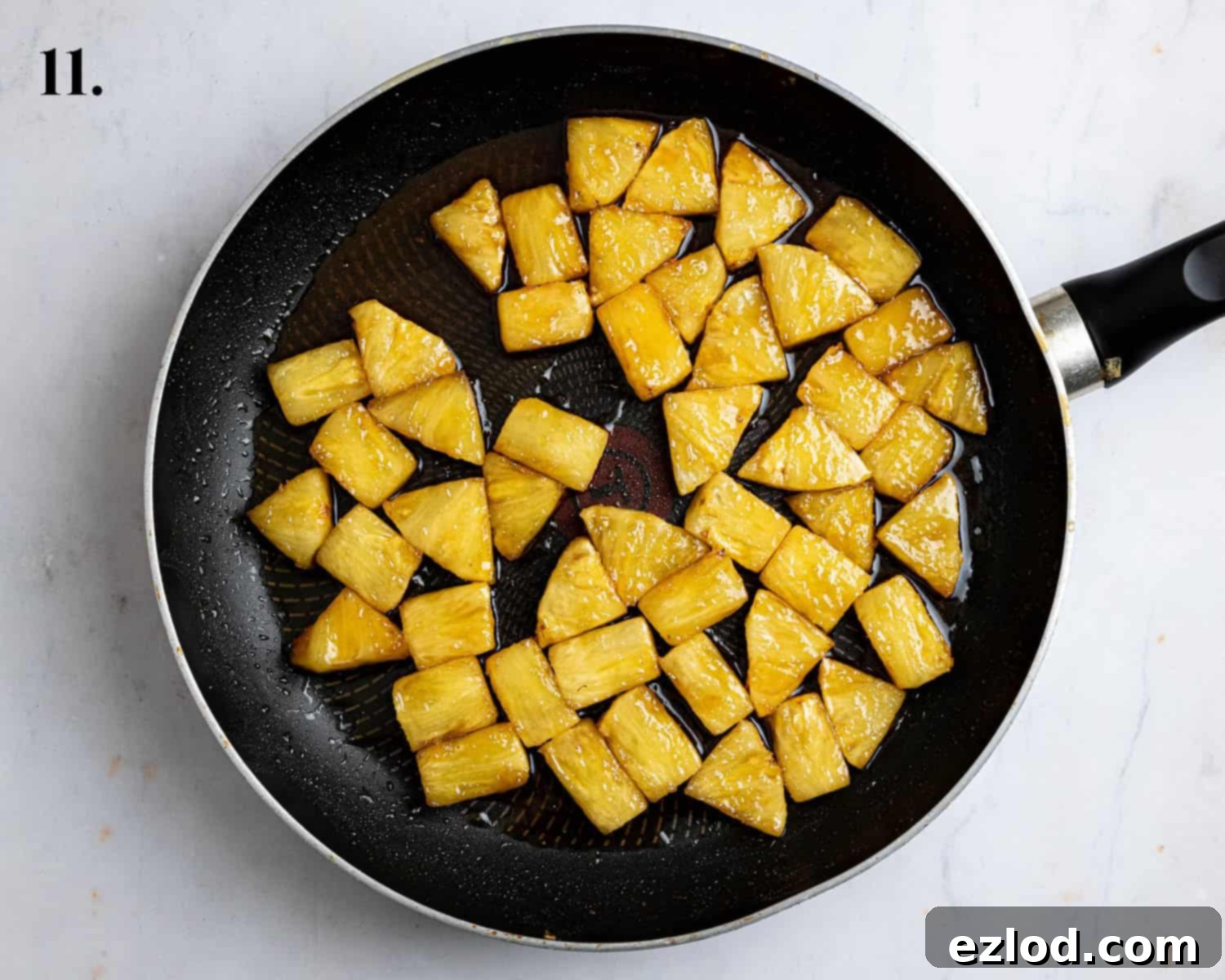
Step 12: Assembling Your Tropical Tart. Once both the pastry case and the crème pâtissière are thoroughly chilled, and the caramelised pineapple has cooled, it’s time to assemble. Give the chilled crème pâtissière a vigorous whisk to restore its smooth and creamy consistency. Spoon or pipe the prepared crème pâtissière evenly into the chocolate-lined pastry case, spreading it out to create a level surface. Finally, artfully arrange the cooled caramelised pineapple pieces on top of the pastry cream. You can arrange them in an intricate pattern or simply scatter them pleasingly over the surface. Serve immediately to enjoy the tart at its peak freshness.
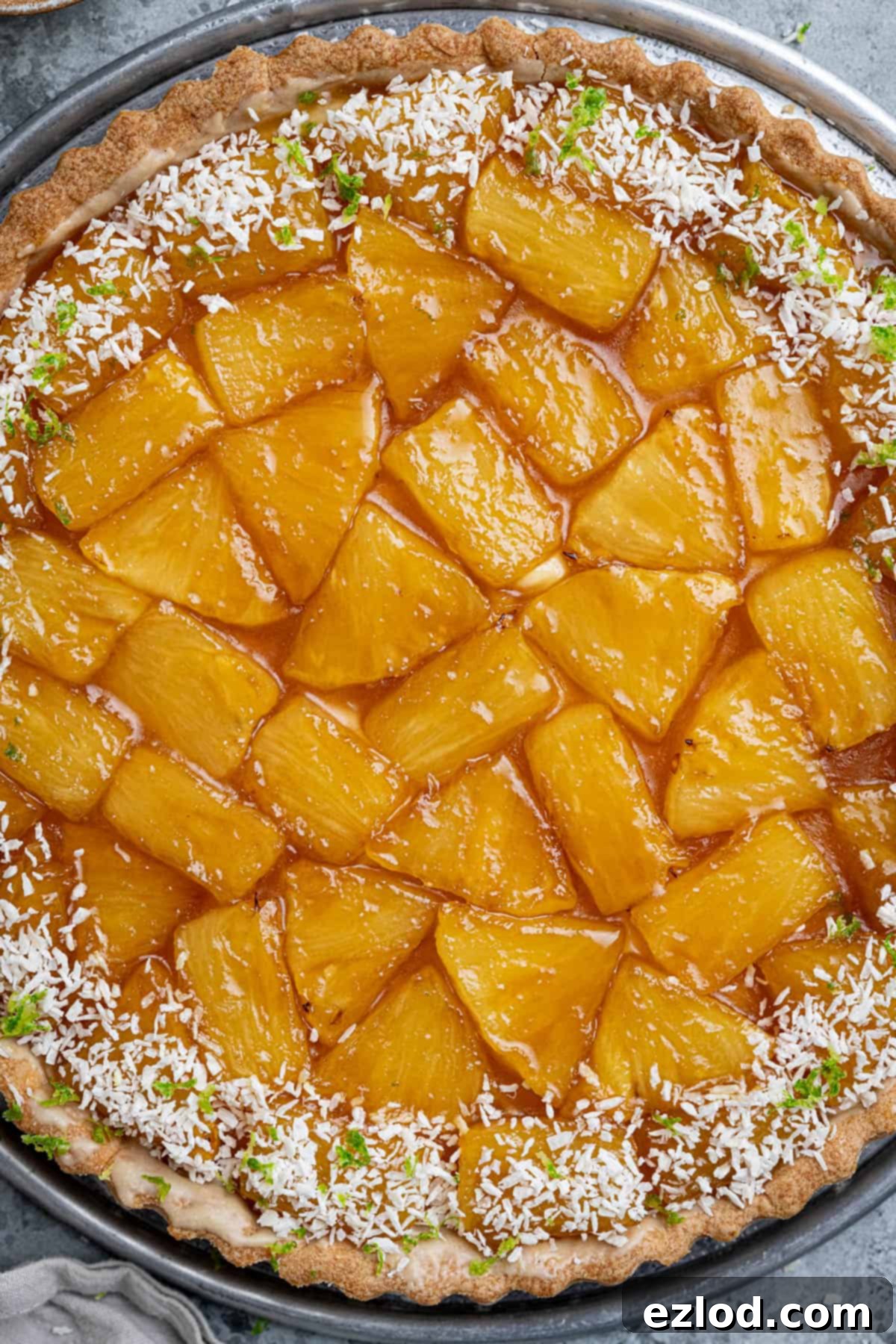
Top Tips for Vegan Tart Perfection: Achieve Flawless Results Every Time
Baking can be an exact science, and a few key tips can elevate your tart from good to truly exceptional:
- Precision with Measurements (Grams vs. Cups): As an ardent baker, I cannot overstate the importance of using metric measurements with a digital kitchen scale, especially for baking. All my recipes are developed using grams for a reason. Cup conversions, while provided for convenience, are notoriously inaccurate due to variations in how ingredients are packed or spooned. Using a digital scale ensures consistent, precise measurements, leading to far better and more reliable baking results. Plus, it’s often quicker and less messy than fiddling with multiple measuring cups!
- The Importance of Chilling Pastry: Never skip the chilling step for your pastry dough. Cold dough is crucial for several reasons: it firms up the butter, which creates pockets for steam and results in a flakier crust; it allows the gluten to relax, preventing the pastry from shrinking excessively during baking; and it makes the dough much easier to handle and roll without sticking or tearing. If your pastry feels too soft or sticky, simply pop it back into the fridge for another 15-30 minutes.
- Avoid Overworking Pastry: Overworking pastry dough develops the gluten, making it tough and chewy rather than tender and crisp. Mix and handle the dough as little as possible, just until it comes together. Freezing the tart shell for 20 minutes before blind baking is another excellent trick; the sudden temperature change helps to ‘shock’ the butter, promoting an even crispier pastry and further preventing shrinkage.
- Prepare Ahead for Ease: Many components of this tart can be prepared in advance, making assembly on the day much simpler. The pastry dough can be made up to two days ahead and stored, tightly wrapped, in the fridge. If it becomes too firm to roll, let it sit at room temperature for about half an hour to soften slightly. The blind-baked pastry case can also be stored in an airtight container at room temperature for a couple of days.
- Shop-Bought Shortcrust Pastry: For those days when time is of the essence, don’t hesitate to use good quality shop-bought shortcrust pastry. Many brands are surprisingly vegan-friendly – just be sure to check the ingredients list carefully. For instance, Jus-Rol’s standard shortcrust pastry is typically vegan (just avoid their ‘all-butter’ variety).
- Mastering the Pastry Cream: When cooking your crème pâtissière, always stir constantly and maintain a low to medium heat. High heat and infrequent stirring are the main culprits behind lumpy or burnt pastry cream. Continuous stirring ensures even cooking and a perfectly smooth, velvety texture. Once it begins to thicken, whisk vigorously for a minute to ensure it’s fully cooked.
- Revitalising Chilled Pastry Cream: After refrigeration, the pastry cream will firm up considerably and might appear somewhat rubbery or jelly-like. Don’t worry, this is completely normal! Before using, simply give it a thorough whisk with a balloon whisk, an electric mixer, or a stand mixer fitted with a paddle attachment. It will miraculously transform back into a wonderfully smooth, spreadable, and pipeable consistency.
Frequently Asked Questions (FAQ’s) About the Caramelised Pineapple Coconut Tart:
Absolutely! The components of this tart can be prepared ahead of time to streamline your baking process. The pastry base can be blind-baked up to 2 days in advance and stored in an airtight container at room temperature. The coconut rum pastry cream can be made 2 days ahead and kept, covered directly with clingfilm or baking paper, in the fridge. Similarly, the caramelised pineapple can be cooked 2 days prior and stored in an airtight container in the refrigerator. For the best flavour and crispest pastry, I highly recommend assembling the tart shortly before you plan to serve it, ideally within a few hours.
Due to the creamy filling, this caramelised pineapple coconut tart must be stored in the refrigerator. Ensure it is covered to prevent it from absorbing any fridge odours and to keep it fresh. It will keep well in the fridge for 3-4 days. However, as with most fresh fruit tarts, its peak freshness and textural perfection (especially the crispness of the pastry) are best enjoyed within 1-2 days of assembly.
Unfortunately, I do not recommend freezing this assembled tart. The delicate texture of both the pastry cream and the caramelised pineapple can suffer significantly upon freezing and thawing, potentially becoming watery or grainy. It’s best enjoyed fresh!
Lumpy pastry cream can happen, even to experienced bakers! If your pastry cream becomes lumpy at any stage – either during cooking or after it has been refrigerated – there’s an easy fix. Simply give it a very good, vigorous whisk until it appears smooth. If lumps persist, press the cream through a fine-mesh sieve using the back of a spoon or a spatula. This will effectively remove any stubborn lumps and restore it to a beautifully smooth, velvety consistency.
While the caramelised pineapple adds a unique depth of flavour and sticky sweetness, cooking the pineapple is not strictly mandatory. The tart remains utterly delicious simply topped with fresh, finely chopped pineapple. For a refreshing twist, you could even try a mix of other tropical fruits, such as fresh mango, passion fruit, or even kiwi, combined with fresh pineapple. This offers a lighter, brighter alternative if you prefer.
Explore More Vegan Tart Recipes for Every Occasion:
- Vegan Rhubarb Tart
- Vegan Passion Fruit Tart
- Vegan Peanut Butter Pie
- Pistachio Cherry Frangipane Tart
- Chocolate Pear Frangipane Tart
- Vegan Jam Crostata
- Vegan Lemon Tart
- Vegan Bakewell Tart
- Vegan Apricot Frangipane Tart
- Vegan Peanut Butter Chocolate Tart
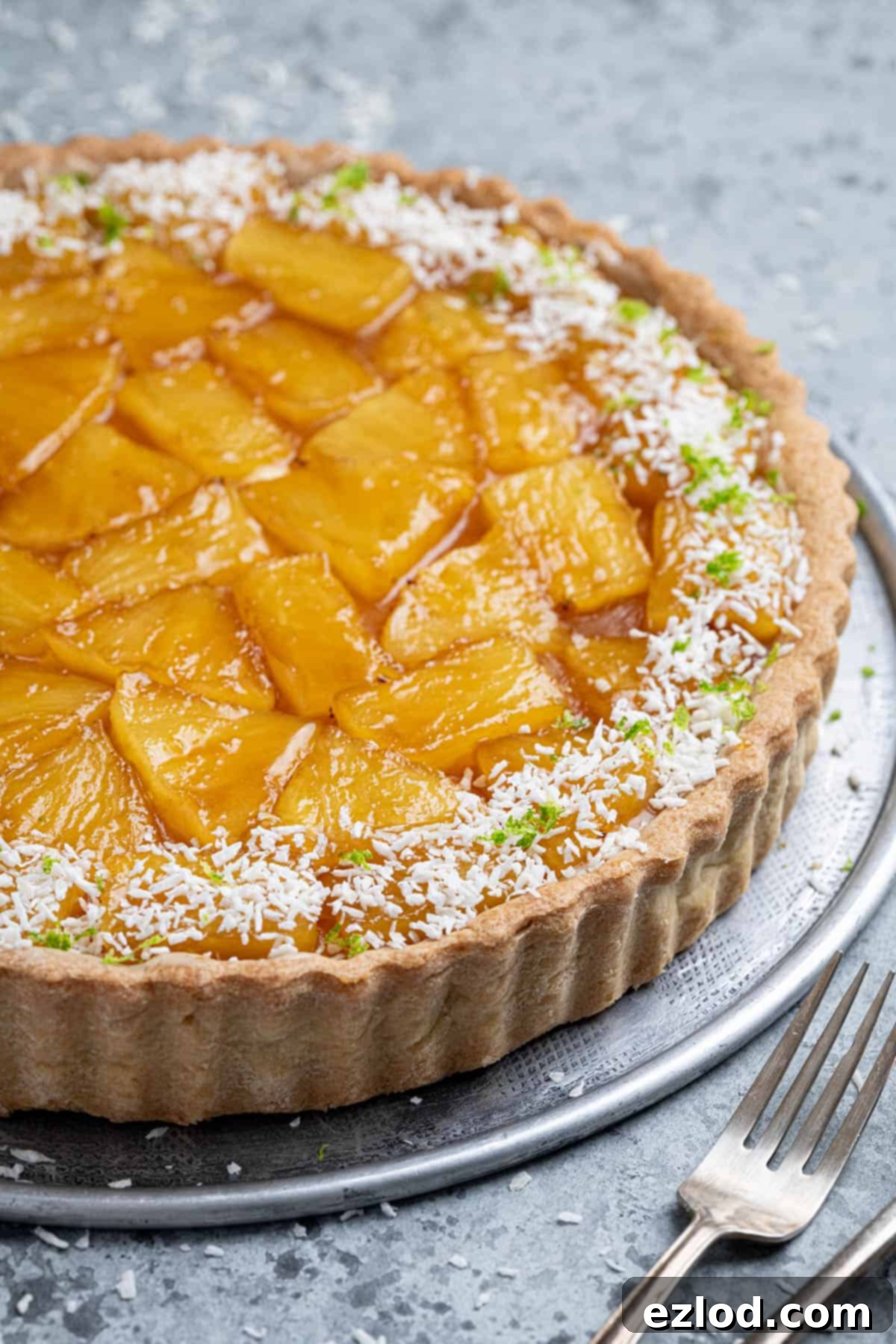
If you tried this delightful recipe and created your own tropical masterpiece, I would be absolutely thrilled to hear about it! Please let me know how it went by rating the recipe, leaving a comment below, or tagging @domestic_gothess on Instagram and using the hashtag #domesticgothess. Your feedback and creations truly inspire me!
All images and content featured on Domestic Gothess are protected by copyright. If you wish to share this recipe with others, please do so respectfully by utilising the provided share buttons. Kindly refrain from screenshotting or posting the recipe or content in its entirety. Instead, please include a direct link to this post for the complete recipe and instructions. Thank you for your understanding and support!

Print
Caramelised Pineapple Coconut tart
Equipment
-
23 – 25 cm (9 – 10 in) loose bottomed tart tin
Ingredients
Pastry:
- 200 g (1 + ⅔ cup) plain (all-purpose) flour
- 50 g (½ cup) ground almonds (almond flour)
- 30 g (⅓ cup) icing (powdered) sugar
- ¼ teaspoon salt
- 130 g (½ cup + 1 Tablespoon) vegan block butter cold and diced
- 1 Tablespoon cold vodka (or water)
Crème pâtissière:
- 60 g (½ cup) cornflour (cornstarch)
- 100 ml (7 Tablespoons) unsweetened non-dairy milk (I use soy)
- 400 ml (14 oz) tin full fat coconut milk
- 100 g (½ cup) caster or granulated sugar
- 1 Tablespoon vanilla bean paste or extract
- 60 g (¼ cup) vegan block butter
- 2 Tablespoons dark rum (optional)
Pineapple:
- 1 medium-large fresh pineapple
- 60 ml (¼ cup) dark rum
- 100 g (½ cup) light brown soft sugar
- juice of ½ lime
- 20 g (4 teaspoons) vegan butter
To assemble:
- 75 g (2 ½ oz) vegan white chocolate melted
- desiccated coconut for sprinkling (optional)
- finely grated lime zest for sprinkling (optional)
Instructions
Pastry:
-
To make the pastry, place the flour, ground almonds, icing sugar and salt in a large bowl and mix well.
-
Add the cold, cubed butter and rub it in using your fingertips until the mixture resembles fine breadcrumbs and no lumps of butter remain.
-
Add the cold vodka (if using) and mix to combine. Gradually add enough cold water to bring the pastry together into a ball. Shape the pastry into a disc (don’t knead it), wrap and refrigerate for about an hour until firm enough to roll out.
-
Roll the pastry out on a lightly floured surface into a circle big enough to line a 23-25 cm (9-10 in) loose bottomed tart tin. Press the pastry right into the corners then trim off the excess.
-
Prick the base of the pastry shell all over with a fork then place it in the freezer for 20 minutes until solid. Meanwhile preheat the oven to 180°C/160°C fan/350°F/gas mark 4.
-
Line the pastry case with baking parchment, pressing it right into the corners, then fill with baking beans or dried rice, making sure that the sides are propped up.
-
Bake for 25 minutes then remove the tin foil and baking beans and return the tart shell to the oven for a further 15-20 minutes until nicely browned. Set aside to cool.
Crème pâtissière
-
Place the cornstarch in a pan and gradually whisk in the soy milk, making sure that there are no lumps. Whisk in the coconut milk, sugar and vanilla.
-
Place the pan over a low-medium heat and stir constantly until it comes up to the boil and thickens. Once it starts to thicken, whisk it vigorously for about a minute, making sure that you get right into the edges of the pan. When you stop for a few seconds, a few big bubbles should rise to the surface and pop.
-
Remove from the heat, add the butter and rum and stir until melted and fully combined.
-
Scrape the pastry cream into a bowl and cover with baking paper or clingfilm directly on the surface of the pastry cream, this will prevent a skin from forming. Refrigerate for at least a couple of hours until cold.
-
Once the pastry cream is cold it will have thickened further and may seem a bit rubbery. Give it a good whisk with a balloon whisk, electric mixer or stand mixer fitted with a paddle attachment and it will become smooth and creamy again. It is now ready to use.
Pineapple:
-
Top and tail the pineapple, cut off the skin and remove the eyes. Cut it into slices about 2-2.5 cm (1 in) wide, remove the core and cut into chunks.
-
Mix together the brown sugar, rum and lime juice in a large bowl and stir in the pineapple, making sure it is well coated.
-
Heat the butter in a large, non-stick frying pan over a medium heat and add the pineapple pieces in a single layer, reserving the juice for later. Cook for 4-5 minutes per side until lightly golden.
-
Add the reserved sugar liquid to the pan and simmer until it has mostly evaporated and thickened to a syrup, stirring every now and again. Set aside to cool.
Assembly:
-
Brush the inside of the cooled pastry case with the melted white chocolate making sure it is well coated and set aside until set.
-
Give the chilled pastry cream a good whisk until it becomes smooth and creamy again then dollop it into the pastry case and spread it level.
-
Arrange the pineapple on top of the pastry cream, you can be artsy and arrange it in a pattern or simply chuck it on haphazardly.
-
Sprinkle over some desiccated coconut and grated lime zest if you like and serve.
Notes
- See post above for tips, details and step-by-step photos.
- All of my recipes are developed using grams, and as with all of my baking recipes I really do recommend using the metric measurements with a digital scale rather than the cup coversions. Cups are a wildly inaccurate measuring system and you will get far better, more consistent results using a scale, not to mention that it is also easier and less messy than cups!
- If the pastry cream becomes lumpy at all, either before or after it is refrigerated, simply give it a good whisk then use the back of a spoon to scrape it through a fine mesh sieve to remove any lumps.
